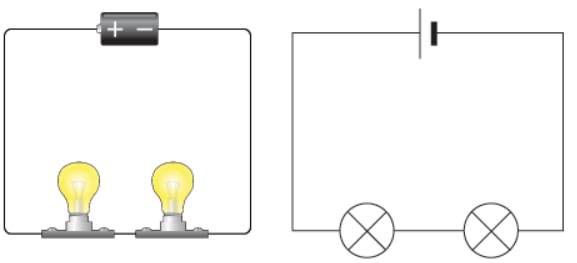Year 6 Exam > Year 6 Notes > Year 6 Science > Electrical components
Electrical components | Year 6 Science PDF Download
The battery
- A circuit always begins with a battery, from which electricity flows from the positive pole to the negative pole.
- The battery drives this flow of electricity through the wires to the other components in the circuit, completing the electrical circuit.

Components in Action
Switches
- A switch in a circuit acts as a controller, capable of breaking the circuit to stop the flow of electricity. It can be strategically placed to control the current in different parts of the circuit.
- Imagine a scenario where you have a fan connected to a switch. When you turn the switch off, the fan stops working due to the circuit being broken.
Bulbs and Buzzers
- Light bulbs illuminate and buzzers emit a sound when electricity flows through them. They demonstrate how electrical energy can be converted into light and sound.
- For example, in a doorbell circuit, when someone presses the button, the buzzer rings due to the flow of electricity.
Voltage
- Voltage, measured in volts (V), acts as the driving force that propels electricity through a circuit. Higher voltage levels mean more energy is being supplied to the components.
- Consider a circuit with multiple light bulbs. Increasing the voltage will result in brighter bulbs due to the increased energy supplied.
Question for Electrical componentsTry yourself: Which component in a circuit acts as a controller to stop the flow of electricity?View Solution
The document Electrical components | Year 6 Science is a part of the Year 6 Course Year 6 Science.
All you need of Year 6 at this link: Year 6
|
11 videos|10 docs|12 tests
|
FAQs on Electrical components - Year 6 Science
| 1. What is the purpose of a battery in an electrical circuit? |  |
Ans. A battery in an electrical circuit serves as a power source, providing the necessary electrical energy to power the components within the circuit.
| 2. How does a battery produce electricity? |  |
Ans. A battery produces electricity through a chemical reaction within its cells, where electrons are transferred between the positive and negative terminals, creating a flow of electrical current.
| 3. What are the different types of batteries commonly used in electronic devices? |  |
Ans. Common types of batteries used in electronic devices include alkaline batteries, lithium-ion batteries, nickel-metal hydride batteries, and lead-acid batteries.
| 4. How can you determine the voltage and capacity of a battery? |  |
Ans. The voltage of a battery is typically labeled on the battery itself, while the capacity is measured in ampere-hours (Ah) or milliampere-hours (mAh) and can be found in the battery's specifications.
| 5. How should batteries be properly disposed of and recycled? |  |
Ans. Batteries should be disposed of properly at designated recycling centers to prevent environmental pollution. Many electronics stores and recycling facilities accept used batteries for recycling.

|
Explore Courses for Year 6 exam
|

|
Signup for Free!
Signup to see your scores go up within 7 days! Learn & Practice with 1000+ FREE Notes, Videos & Tests.
Related Searches

















